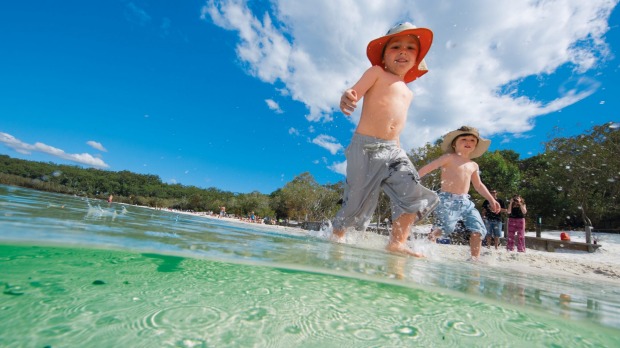
"Daddy, I'm a bit bored of whale watching," says seven-year-old Mila on the penultimate afternoon of our five-day Fraser Island sojourn.
To be fair, my eldest daughter's protestation comes on our second three-hour Hervey Bay whale-watching tour, during which humpback sightings have been as common as Tony Abbott faux-pas.
But for me, flying solo with my two girls on a first proper holiday without their mum, it is a salutary lesson. No matter how activity-packed our stay at Kingfisher Bay resort has been, I realise, while you can please some little people some of the time, you can't please all the little people all of the time.
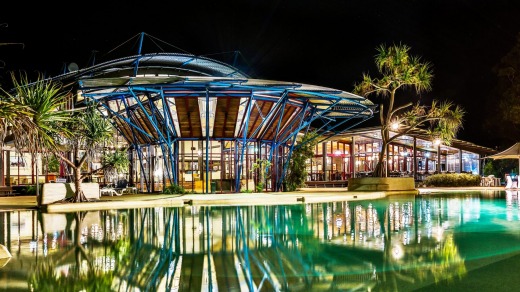
So far, largely thanks to resort staff, this single-dad operation has been seamless and, anyhow, Mila's boredom lasts only until afternoon tea appears aboard the Quick Cat II whale-watching boat.
The first smiling face we see on arrival at Kingfisher Bay's wharf is that of operations manager Leanne Ellams. She quickly gathers us up and takes us to our well-equipped two-bedroom villa. Set back from the resort hub-bub and surrounded by tropical foliage, it's a spacious hideaway where we can all recoup energy between tours and swims. Leanne, a qualified babysitter, is also on hand one afternoon to care for the girls while I have a much-needed massage in the Kingfisher Natural Therapy spa.
To a dad unused to the demands of constant parenting, it's no exaggeration to say that staff like Ellams and ranger Peter Meyer are the heroes of the trip, both helping out physically and making sure everything's fun.
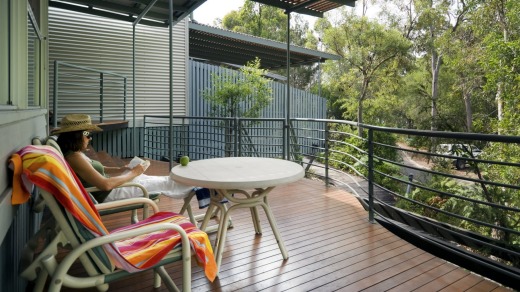
Our ranger guide Meyer, who shows us Fraser Island's highlights in a four-wheel drive on our second morning, is an instant hit with both Mila and my five-year-old Freya. He calls them "pixies" all day.
He takes us first into the island's interior, weaving the Butchulla creation story behind Fraser into our bumpy drive along sand tracks.
"The Butchulla called the island K'gari," says Meyer, "which is pronounced 'Gurri", after the beautiful spirit who helped the god Beeral's messenger Yindingie create the land."
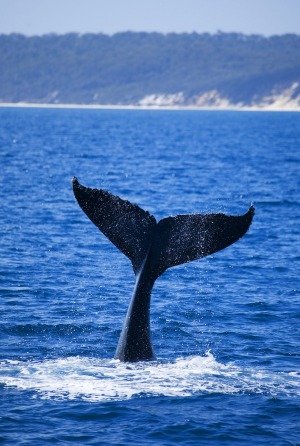
"She worked very hard and fell asleep on some rocks by the sea," he continues simply, "and when she woke she fell in love with the idyllic bay Yindingie had created."
"She asked to stay so he transformed her into the island," he adds, as my girls' eyes widen, "with its tall trees and big lakes and flowers, animals and children for company."
We stop at Pile Valley and take a short walk among satinay, turpentine and brush box trees, some 40 metres high. It's only an hour into our tour and Meyer is giving a piggyback to five-year-old Freya, who looks like the cat that's got the cream.
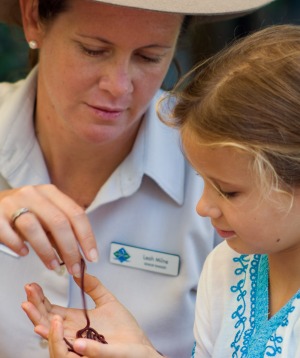
Later we follow the course of Wanggoolba Creek through the rainforest close to Central Station, a clearing that was the headquarters of the island's forestry industry between 1920 and 1950. It once had a school for loggers' children and 30 houses. Here, Meyer shows us an epiphyte staghorn fern sprouting from a kauri pine and the girls pose for photographs wearing its extravagant foliage around their necks.
While World-Heritage-listed Fraser is the planet's biggest sand island, 120km long and covering an area of 184,000 hectares, it also encompasses Australia's second largest concentration of lakes (after Tasmania). There are more than 70, including 40 perched lakes that are rarely found elsewhere. They are formed when organic matter hardens in the wind.
Lake McKenzie is one such perched lake that has evolved to appear like an inland Tahitian lagoon, sapphire-coloured and with shores formed of virtually pure silica. Fraser is surrounded by ocean but this is the island's most alluring swimming pool.
For lunch, Meyer chooses a lookout over another eye-catching waterway, Lake Wabby. The semi-circular lake is cradled by eucalypt woods at the base of a sandblow that is gradually gobbling it up. It's as olive-green as McKenzie is blue and our view of it is filled with a rare conjunction of lake, forest, dunes and ocean.
In the afternoon we descend to Fraser's 120km east-coast beach, driving at the edge of breaking waves to the rusting hulk of the Maheno, a liner that ran aground in 1935. The wreck is a reminder of the sometimes treacherous conditions that have claimed at least 50 ships off Fraser. Indeed, the island was renamed after Eliza Fraser, a survivor of the 1836 wreck of The Stirling Castle.
After an obligatory float down the translucent Eli Creek, a shallow freshwater stream that swirls onto the sand, we get a glimpse of Fraser from above on a scenic flight that uses the beach as an air strip.
It's been a long but captivating day, so after a quick dinner back at Kingfisher, I put two very tired but happy girls straight to bed.
Over our five-day break the resort's choice of eateries gives us the right spot for any mood or time of day. For breakfasts and most evening meals there's the Maheno restaurant, named after that shipwrecked liner, and for one gourmet dinner there is Seabelle, where the chef dabbles with native ingredients like pepperberries and warrigal greens.
At Seabelle, both fussy daughters improbably try a juniper berry salt and pepper crocodile and calamari salad, while I make my way through a K'gari tasting plate that includes tea-tree-smoked kangaroo with bush tomato chutney and emu with rosella sauce. But with kids on board, an alfresco pizza down at the Sand Bar, on the jetty, is hard to beat.
On our two half-days at the resort, we rarely leave the pool or the bubbling spa. When we do it's for a dip in the ocean from Kingfisher's beach or to expend more energy – if only parents had half as much oomph as our kids – in Kingfisher's shaded playground.
But between July and November, there is no greater thrill to be had on a visit to Fraser than whale watching in the adjacent Hervey Bay Marine Park.
So, on our third morning we are up early to join the pioneers of Hervey Bay whale watching, Jill and Brian Perry, for a tour. The Perrys first ran trips back in the late 1980s and Brian Perry, skipper of Quick Cat II, knows the intricacies of whale behaviour well.
As we head out through the Great Sandy Strait, which separates Fraser from the mainland, conditions look ideal. It's a clear, sunny day and the bay is barely raising a ripple.
The moment we enter the broader bay we see our first whales: a mother and her calf rolling idly through the sea. These protected waters are an important rest stop for humpbacks and their newborns on their migration south to Antarctica, and it's soon clear that we're witnessing a swimming lesson, the calf mimicking the larger whale's every move. The pair stay within 50 metres of the stationary boat for half an hour and, when we pull away, the baby lifts its tail above the surface as if to wave goodbye.
Ten minutes later we are "ambushed" by another two humpbacks. First a 5m infant swims straight toward the boat, passing within arm's length of Mila, holding tight onto the bow rail. Then its much larger mother comes sharply into focus immediately below us. As the colossus lolls by, its every marking and barnacle visible in the crystalline blue sea and with the shadows of spectators projected onto its body, its size and proximity cause us to genuinely draw breath.
Then she starts showing off, spurting spray from her blowhole, raising her tail fluke to nearly touch us, and finally turning, puppy-like, onto her back as if to say, "Tickle my tummy".
It's an impossible act to follow, but nonetheless several other whales come close to doing so on a memorable morning. It's such a show that we return the following afternoon for more. In rougher seas we don't get so close this time but do witness some baleen high jinks, including a full-body breach, from afar.
It's toward the end of this second tour, when my seven-year-old expresses her ennui with humpack whales, that I begin to wonder whether this action-crammed Fraser Island adventure might have raised the bar of my children's holiday expectations just a tad too high.
The Scott family travelled courtesy of Tourism Queensland and were guests of Kingfisher Bay resort.
A 45-minute chef-led session in Seabelle restaurant on where to find native ingredients in their raw form and how to use them in cooking. $15 a person.
A 90-minute ranger-led tour among the mangroves of nearby Dundonga creek. $20 an adult, $7.50 a child.
Set off on an independent off-road tour along the inter-tidal zones and varied landscapes of Fraser's west coast, from $79 a person.
Learn how to fish straight from the jetty for species like bream, flathead and trevally. Kingfisher Bay is such a hotspot that it's hosting the Australian Fishing Championships in 2015. Clinics cost $5 an adult, $3 a child.
Spotlight nocturnal creatures such as sugar gliders and rare acid frogs on a guided island night walk. $5 an adult, $3 a child.
visitfrasercoast.com
Virgin Australia flies direct to Hervey Bay from Melbourne and Sydney. See virginaustralia.com.
A shuttle bus ($20 return) runs from the airport to River Heads ferry terminal. The passenger ferry takes 50 minutes to reach Kingfisher Bay and costs $50 return (children $25).
Kingfisher Bay Resort, Fraser Island offers 2-bedroom villas from $268 a night, rising to $418 in peak season. Phone 1800 072 555, see kingfisherbay.com.